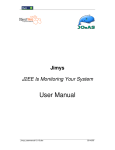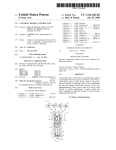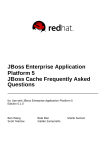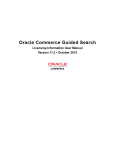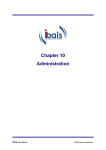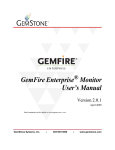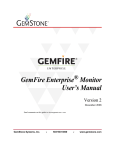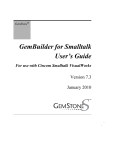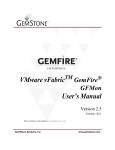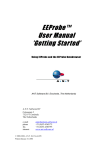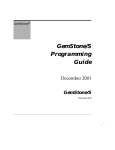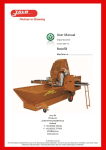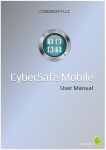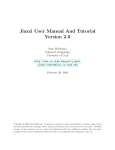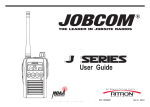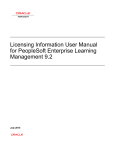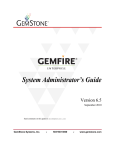Download GemFire Enterprise DataBrowser User`s Manual
Transcript
GemFire Enterprise DataBrowser User's Manual Version 1.1 August 2009 Copyright 2009 GemStone Systems, Inc. Send comments on this guide to [email protected] GemStone Systems, Inc. ▼ +1-503•533•3000 ▼ www.gemstone.com 1 INTELLECTUAL PROPERTY OWNERSHIP This documentation is furnished for informational use only and is subject to change without notice. GemStone Systems, Inc. assumes no responsibility or liability for any errors or inaccuracies that may appear in this documentation. This documentation, or any part of it, may not be reproduced, displayed, photocopied, transmitted, or otherwise copied in any form or by any means now known or later developed, such as electronic, optical, or mechanical means, without express written authorization from GemStone Systems, Inc. Warning: This computer program and its documentation are protected by copyright law and international treaties. Any unauthorized copying or distribution of this program, its documentation, or any portion of it, may result in severe civil and criminal penalties, and will be prosecuted under the maximum extent possible under the law. The software installed in accordance with this documentation is copyrighted and licensed by GemStone Systems, Inc. under separate license agreement. This software may only be used pursuant to the terms and conditions of such license agreement. Any other use may be a violation of law. Use, duplication, or disclosure by the Government is subject to restrictions set forth in the Commercial Software - Restricted Rights clause at 52.227-19 of the Federal Acquisitions Regulations (48 CFR 52.227-19) except that the government agency shall not have the right to disclose this software to support service contractors or their subcontractors without the prior written consent of GemStone Systems, Inc. This software is provided by GemStone Systems, Inc. and contributors “as is” and any expressed or implied warranties, including, but not limited to, the implied warranties of merchantability and fitness for a particular purpose are disclaimed. In no event shall GemStone Systems, Inc. or any contributors be liable for any direct, indirect, incidental, special, exemplary, or consequential damages (including, but not limited to, procurement of substitute goods or services; loss of use, data, or profits; or business interruption) however caused and on any theory of liability, whether in contract, strict liability, or tort (including negligence or otherwise) arising in any way out of the use of this software, even if advised of the possibility of such damage. COPYRIGHTS This software product, its documentation, and its user interface Copyright © 1997-2009 GemStone Systems, Inc. All Rights Reserved by GemStone Systems Inc. Java Software technologies Copyright © 1994-2000 Sun Microsystems, Inc. All rights reserved. Trove Log4J Copyright © 1999 The Apache Software Foundation. All rights reserved. The Trove library is licensed under the Lesser GNU Public License, which is included with the distribution in a file called LICENSE.txt. PrimeFinder and HashFunctions classes in Trove © Copyright 1999 CERN European Organization for Nuclear Research. JavaGroups copyright © 1999-2004 Free Software Foundation, Inc. GNU Trove copyright © 2001-2004 Eric D. Friedman. The PrimeFinder and HashFunctions classes in Trove are copyright © 1999 CERN - European Organization for Nuclear Research. Copyright © 1991, 1999 Free Software Foundation, Inc. 59 Temple Place, Suite 330, Boston, MA 02111-1307 USA GemStone Systems, Inc. ▼ +1-503•533•3000 ▼ www.gemstone.com 2 MX4J project (http://mx4j.sourceforge.net). Copyright © 2001-2004 by the MX4J contributors. All rights reserved. Commons Modeler Copyright © 2004 Commons Modeler. All rights reserved. JDBM Copyright © 2000 Cees de Groot. All Rights Reserved. Contributions are Copyright © 2000 by their associated contributors. Copyright (C) 2006, Hitachi, Ltd. All Rights Reserved. Copyright © 1994 Hewlett-Packard Company Copyright © 1996,97 Silicon Graphics Computer Systems, Inc. Copyright © 1997 Moscow Center for SPARC Technology. Copyright © 1998-2003 Daniel Veillard. All rights reserved. Jgroups © 2001, 2002 www.jgroups.org Antlr © 2005, Terence Parr. All rights reserved. PATENTS GemFire is protected by U.S. patent 6,360,219. Additional patents pending. TRADEMARKS GemStone, GemFire, GemFire Enterprise, and the GemStone logo are trademarks or registered trademarks of GemStone Systems, Inc. in the United States and other countries (trademark application pending for GemFire). UNIX is a registered trademark of The Open Group in the U. S. and other countries. Linux is a registered trademark of Linus Torvalds. Red Hat and all Red Hat-based trademarks and logos are trademarks or registered trademarks of Red Hat, Inc. in the United States and other countries. SUSE is a registered trademark of SUSE AG. Sun, Sun Microsystems, Solaris, Forte, Java, Java Runtime Edition, JRE, and other Java-related marks and logos are trademarks or registered trademarks of Sun Microsystems, Inc. All SPARC trademarks are used under license and are trademarks or registered trademarks of SPARC International, Inc. in the United States and other countries. Products bearing SPARC trademarks are based upon an architecture developed by Sun Microsystems, Inc. Intel and Pentium are registered trademarks of Intel Corporation in the United States and other countries. Microsoft, Windows, and Visual C++ are registered trademarks of Microsoft Corporation in the United States and other countries. Exolab is a registered trademark of ExoLab Group. IBM, AIX, and developerWorks are registered trademarks of IBM Corporation. W3C is a registered trademark of the World Wide Web Consortium. GemStone Systems, Inc. ▼ +1-503•533•3000 ▼ www.gemstone.com 3 Other company or product names mentioned herein may be trademarks or registered trademarks of their respective owners. Trademark specifications are subject to change without notice. All terms mentioned in this documentation that are known to be trademarks or service marks have been appropriately capitalized to the best of our knowledge; however, GemStone cannot attest to the accuracy of all trademark information. Use of a term in this documentation should not be regarded as affecting the validity of any trademark or service mark. GemStone Systems, Inc. 1260 NW Waterhouse Avenue, Suite 200 Beaverton, OR 97006 GemStone Systems, Inc. ▼ +1-503•533•3000 ▼ www.gemstone.com 4 Table of Contents GemFire Enterprise DataBrowser User's Manual......................................................................................1 INTELLECTUAL PROPERTY OWNERSHIP...............................................................................2 COPYRIGHTS.................................................................................................................................2 PATENTS..........................................................................................................................................3 TRADEMARKS...............................................................................................................................3 Preface........................................................................................................................................................6 About This User Manual.......................................................................................................................6 Other References...................................................................................................................................6 Technical Support..................................................................................................................................6 Preserving Artifacts for Technical Support...........................................................................................6 Contacting Technical Support...............................................................................................................7 24x7 Emergency Technical Support......................................................................................................8 GemFire Developer Corner...................................................................................................................8 Training and Consulting........................................................................................................................8 Chapter 1: Introduction to GemFire Enterprise DataBrowser...................................................................9 Chapter 2: Installation..............................................................................................................................10 Licensing.............................................................................................................................................10 Chapter 3: Running DataBrowser............................................................................................................11 Chapter 4: Connecting to a GemFire Distributed System........................................................................12 Chapter 5: Tour of the DataBrowser........................................................................................................13 Main Window......................................................................................................................................13 Toolbar.................................................................................................................................................14 Menu....................................................................................................................................................14 Region List..........................................................................................................................................14 Member List........................................................................................................................................14 Query Pane..........................................................................................................................................14 Results Pane........................................................................................................................................14 Continuous Query................................................................................................................................14 Export Results.....................................................................................................................................16 Explore Functionality..........................................................................................................................16 Chapter 6: Preferences.............................................................................................................................17 Connection...........................................................................................................................................17 Query...................................................................................................................................................17 Security................................................................................................................................................17 Miscellaneous......................................................................................................................................18 Chapter 7: How DataBrowser Works.......................................................................................................19 Discovery.............................................................................................................................................19 Query Execution..................................................................................................................................19 Security................................................................................................................................................19 Appendix A: DataBrowser Product Tree.................................................................................................21 GemStone Systems, Inc. ▼ +1-503•533•3000 ▼ www.gemstone.com 5 Preface About This User Manual This user manual describes the GemStone® GemFire Enterprise® DataBrowser tool, which is used to execute ad-hoc queries on data regions on cache servers in a GemFire Enterprise distributed system. The document assumes familiarity with basic Java terminology and programming practices. Other References The GemFire Enterprise Developer’s Guide describes the major services and functions in GemFire Enterprise, including the query facilities provided in GemFire Enterprise. The GemFire Enterprise System Administrator's Guide describes how to configure and deploy a GemFire Enterprise distributed system including Cache Servers and AdminAgents. Technical Support GemStone provides several sources for product information and support. The GemFire Enterprise Developer’s Guide, the GemFire Enterprise System Administrator’s Guide and the GemFire Enterprise online Java API provide extensive documentation, and should always be your first source of information. GemStone Technical Support engineers will refer you to these documents when applicable. However, you may need to contact Technical Support for the following reasons: • Your technical question is not answered in the documentation. • You receive an error message that directs you to contact GemStone Technical Support. • You want to report a bug. • You want to submit a feature request. Questions concerning product availability, pricing, or future features should be directed to your GemStone account manager. Questions about licenses should be email to [email protected]. Preserving Artifacts for Technical Support If you have a hung VM and you do not have to kill it, leave it while you contact Technical Support. If you cannot leave the VM running, and it is running under Unix, signal it twice with this command, letting five to ten seconds pass between the two signals: kill -QUIT pid This will send the VM’s stack dumps into the log file for inspection. For Windows systems, call Technical Support for assistance in obtaining stack dumps. Don’t delete any files until you call Technical Support and find out exactly what data may be useful to Support or Engineering. Save all the artifacts, including: • Log files. Send the full log to Technical Support, not just the stack. Even at the default logging GemStone Systems, Inc. ▼ +1-503•533•3000 ▼ www.gemstone.com 6 level, the log contains data that may be important, such as the operating system and license. • Core files. • For Linux, you can use gdb to extract a stack from a core file. Call Technical Support if you need assistance. • Crash dumps. • For Windows, save the Dr. Watson output. Contacting Technical Support When contacting GemStone Technical Support, please be prepared to provide the following information: • Your name, company name, and GemFire license number • The GemFire product and version you are using • The hardware platform and operating system you are using • A description of the problem or request • Exact error messages received, if any • Any artifacts in the preceding list Your GemStone support agreement may identify specific individuals who are responsible for submitting all support requests to GemStone. If so, please submit your information through those individuals. All responses will be sent to authorized contacts only. For non-emergency requests, you should contact Technical Support by web form or E-mail. You will receive confirmation of your request, and a request assignment number for tracking. Replies will be sent by E-mail whenever possible, regardless of how they were received. GemStone Support Website: http://techsupport.gemstone.com This is the preferred method of contact. The 'Submit A Request' link toward the top left of the home page—please use this to submit help requests. This form requires an email address for registration. Registration is free of charge. To register, click on the 'Sign-up' link at the top left corner of the home page and complete the Registration Form. Alternatively, you can submit your request along with your email and you will receive a verification email with a URL where you can create your account. E-mail: [email protected] Please do not send files larger than 100K (for example, core dumps) to this address. A special address for large files will be provided as appropriate. Telephone: (800) 243-4772 or (503) 533-3503 We recommend that you call only for more serious requests that require immediate evaluation, such as a production system that is non-operational. Emergency requests are handled by the first available engineer. If you are reporting an emergency and you receive a recorded message, do not use the voice mail option. Transfer your call to the operator, who will take a message and immediately contact an engineer. GemStone Systems, Inc. ▼ +1-503•533•3000 ▼ www.gemstone.com 7 Non-emergency requests received by telephone are placed in the normal support queue for evaluation and response. 24x7 Emergency Technical Support GemStone offers, at an additional charge, 24x7 emergency technical support. This support entitles customers to contact us 24 hours a day, 7 days a week, 365 days a year, if they encounter problems that cause their production application to go down, or that have the potential to bring their production application down. Contact your GemStone account manager for more details. GemFire Developer Corner More information about GemFire products can be obtained by visiting the GemFire Developer Corner at http://developer.gemstone.com. You can find useful information, such as: • Product FAQs http://developer.gemstone.com/display/gfedev/GemFire+Product+FAQs • Hands-on examples and code samples http://developer.gemstone.com/display/gfedev/Get+Hands-On+with+GemFire • GemFire technology use cases and design patterns http://developer.gemstone.com/display/gfedev/Using+GemFire+in+Your+Organization Training and Consulting Consulting and training for all GemStone products are available through GemStone’s Professional Services organization. • Training courses are offered periodically at GemStone’s offices in Beaverton, Oregon, or you can arrange for onsite training at your desired location. • Customized consulting services can help you make the best use of GemStone products in your business environment. Contact your GemStone account representative for more details or to obtain consulting services. GemStone Systems, Inc. ▼ +1-503•533•3000 ▼ www.gemstone.com 8 Chapter 1: Introduction to GemFire Enterprise DataBrowser As implied by its name, the DataBrowser allows developers and administrators to connect to a GemFire Enterprise distributed system to browse data using ad-hoc OQL queries. DataBrowser is designed to work with GemFire Enterprise 6.0 or higher. The DataBrowser provides the following features: • Execute ad-hoc queries on any data region on any cache node in the distributed system, and display the results in a tabular format with the ability to drill to down into complex nested objects. • The maximum number of rows returned by any query can be configured to prevent excessive resource utilization on the server. • Multiple “Continuous Queries” can also be simultaneously executed on one or more cache servers in the distributed system. The results are continuously updated in a tabular window. • Security credentials can be provided when connecting to a distributed system through a plug-in mechanism. The GemStone tools development team welcomes feedback to improve the DataBrowser. Please report any comments, bugs and suggestions at http://techsupport.gemstone.com GemStone Systems, Inc. ▼ +1-503•533•3000 ▼ www.gemstone.com 9 Chapter 2: Installation GemFire Enterprise DataBrowser is designed to run on Microsoft Windows and Red Hat Linux. DataBrowser requires the Java Runtime Environment (JRE), 1.5 or higher to run. GemFire Enterprise 6.0 is required on the distributed system on which the DataBrowser will execute queries. A machine with Intel® 2 GHz Pentium® 4 (or equivalent) and 2 GB RAM is the minimum recommended hardware. You may also consider explicitly setting the JVM heap size in the DataBrowser startup scripts to a value suitable for the result sizes that would be returned from your distributed system. DataBrowser is distributed as a ZIP archive. Extract the contents of the ZIP archive to a temporary location, and then execute the jar to install the product. You will be prompted through a sequence of steps, including selection of the file system location in which the software is installed. You can uninstall DataBrowser by simply deleting the file system tree in which the archive was extracted. See Appendix A later in this document for a description of the product tree. Licensing DataBrowser is licensed as a package along with GemStone GemFire Enterprise. You will require a GemFire license file to use DataBrowser. The AdminAgent used by the DataBrowser to connect to the distributed system and the ability to connect to a distributed system requires a GemFire license. For more information about GemFire licenses, see the GemFire Enterprise documentation. For licenses, contact [email protected]. GemStone Systems, Inc. ▼ +1-503•533•3000 ▼ www.gemstone.com 10 Chapter 3: Running DataBrowser After installing the DataBrowser and a supported JRE, use the following steps start the DataBrowser • Execute 'agent start' in the GemFire product bin directory to start the AdminAgent in the GemFire distributed system. Refer to 'Using JMX to Administer GemFire' in the GemFire Enterprise System Administrator's Guide to start the AdminAgent with non-default options. By default, the AdminAgent listens on port 1099 for RMI clients. • Set the GEMFIRE environment variable to point to the product directory containing the same gemfire.jar used by the AdminAgent. • Add any application classes in the classpath. These can also be set in the DataBrowser's preferences. • Execute databrowser.bat on Microsoft Windows or the databrowser shell script on Linux to start DataBrowser. The DataBrowser connects to the AdminAgent to discover the data regions and cache servers in a GemFire distributed system and display them in the user interface. Queries must be executed by selecting data region, and optionally, a member on which the region is located. If no member is selected, the DataBrowser automatically selects the first member cache server. The DataBrowser does not guard against executing complex queries, e.g. those that do a join across regions, on a cache server that does not have all the regions specified in the query. GemStone Systems, Inc. ▼ +1-503•533•3000 ▼ www.gemstone.com 11 Chapter 4: Connecting to a GemFire Distributed System Once the DataBrowser is running, you can connect to a GemFire distributed system by clicking on the toolbar item labeled 'Connect to GemFire..' or selecting the File menu item of the same name. This displays the 'Connect to GemFire distributed system' popup dialog. Figure 4.1: Connect To GemFire Distributed System The host and port fields refer to that of the RMI enabled AdminAgent in the GemFire distributed system to which you want to connect. These host port combinations are saved by the DataBrowser to allow you to easily select a previous AdminAgent from the drop down lists in this dialog. You can set the number of entries in this list in the Connection Preferences dialog. Once connected to the distributed system, the DataBrowser fetches the GemFire regions present in the distributed system, as well as the members on which they are located. RMI requires the host name to not contain certain reserved characters such as %, $, and -. For a complete list of reserved characters consult RFC 952. If your host names contain non-compliant characters, we recommend using the IP address instead. GemStone Systems, Inc. ▼ +1-503•533•3000 ▼ www.gemstone.com 12 Chapter 5: Tour of the DataBrowser Main Window The Main Window is displayed once the application has started. All of DataBrowser's functionality is available through this window. Figure 5.1: Main Window Toolbar The toolbar is where you can access most of the functionality offered by the DataBrowser, including the ability to connect to and disconnect from a distributed system, specify security properties, execute queries, and export results to an XML file. Menu In addition to the functionality accessible through the toolbar, the menu allows you to set your preferences for the application via the Options item. This displays the Preferences dialog that allows you to set your preferences for connections made to distributed systems, query execution, security preferences, and other miscellaneous options such as additional classpath components for the application, location of the log file, logging level among others. Region List This shows the regions that are present in the distributed system. This information is refreshed according to the interval specified in the application preferences. The list is displayed as a tree where the child nodes represent child regions of a GemFire regions. Member List When a region is selected the GemFire members on which the region occurs are displayed in this list. Right-clicking on an item in this list of members, displays a context menu that allows you to execute a ContinuousQuery (CQ) on the member for the selected region. Query Pane This pane is a multi-line editor that allows you to enter OQL queries for execution. If a line is selected, the text on the line is the query string used for execution. Else, if no line is selected, the text of the last line is automatically used as the query string for execution. Results Pane The results pane displays each results item in the table in the pane. Multiple tabs may be displayed under the results pane, each tab representing a specific Java type returned in the results. GemStone Systems, Inc. ▼ +1-503•533•3000 ▼ www.gemstone.com 13 Continuous Query A ContinuousQuery is syntactically identical to a regular GemFire OQL query, except that once its is registered on the member, the member continues sending result items that match the query specifications as changes happen in the region on the member. Unlike the Main Window, the Continuous Query window has only a single item in its toolbar that allows you to stop the execution of the CQ. It also shows some additional information about the query as it is being executed on the member. This includes the total number of events that have occurred on the member since the CQ was registered, including inserts, updates and deleted. Each Results tab, in a ContinuousQuery window, has a drop down list that contains the field (columns in the table) names of the items in the results. This is useful in filtering the results. Selecting a field in this list allows you to filter the results displayed in the table by having it display only unique values for that field. For example, if one of the fields in the query results is a zip code, applying a filter on that field will result in the table displaying only a single row for each unique zip code returned by the query. There is also an embedded pane that shows any messages or exceptions returned by the member. Figure 5.2: ContinuousQuery Window Export Results The contents of the Results pane in the Main Window can be exported to an XML file. An associated XSD is also created. This allows you to capture the results and manipulate it and examine it further using other tools at a later point in time. Explore Functionality The Results Pane in both the Main window and the CQ window has a context menu applicable to a single table row that allows you to drill down into the record in the result set. This is particularly useful to examine a record that contains fields that are collections or composite types. To view custom application types, you must include the jars in the CLASSPATH or specify their location in the DataBrowser preferences. GemStone Systems, Inc. ▼ +1-503•533•3000 ▼ www.gemstone.com 14 Chapter 6: Preferences User specified preferences can be set in the Preferences dialog. This dialog is accessible through the 'Options->Preferences...' menu. The preferences are categorized into 4 types 1. Connection 2. Query 3. Security 4. Miscellaneous Connection This allows you to specify four settings: • Number of entries to keep in history list of AdminAgents to which you connected. • The timeout, in milliseconds, to be used on connection attempts to the AdminAgent. Query This allows you to specify the following: • Whether the DataBrowser should automatically append a LIMIT clause, if not already present in a query, and the limit on the items in the result set. This can help avoid out of memory situations in cases where the heap size of the VM used by the DataBrowser is not sufficient when the query results in extremely large data volumes being returned. This preference setting does not apply to CQs. Security These preferences allow you to specify a jar that implements the GemFire Enterprise security plug-in interface, and define properties that are supplied when the interface is invoked when executing queries on a cache server. The 'hidden' checkbox toggles the masked state of the values provided. Optionally, you can import properties from a property file by clicking on the 'Import' button. The 'Security' group box that contains the UI controls specific to security are also displayed in a pop-up dialog that is displayed when you click on the 'Specify Security..' button on the toolbar in the Main Window. GemStone Systems, Inc. ▼ +1-503•533•3000 ▼ www.gemstone.com 15 Figure: 6.1 Miscellaneous This allows you to specify • Logging settings. • The rate at which the DataBrowser updates its view of regions and members in the distributed system. • Add custom application jars to the DataBrowser's classpath. The logging settings are applied when you restart DataBrowser. These settings allow you specify the following • Location of the log files. • The maximum size of a log file. When a log file reaches this threshold, the log file is rolled over and a new log file may be created and the oldest one may be deleted. • Number of rolled over log files to store. When log files reach their size threshold, logging rolls over to a new file. This value specifies the maximum number of rolled log files to keep. Then the number of rolled over log files is reached, the oldest one is deleted. Chapter 7: How DataBrowser Works DataBrowser interacts with GemFire Enterprise both as a GemFire client and as an RMI client of the AdminAgent. Discovery As an RMI client, it uses JMX to get information about the data regions in the distributed system and the servers on which they are located. This information is displayed on the left side of the Main Window, where the data regions are displayed in a hierarchical tree, with child data regions displayed as sub-nodes of their parent data region. The lower pane on the left shows the list of cache servers on which the region selected in the upper list is located. Query Execution A region must be selected to execute a query specified in the Query Pane. You may also select a cache server on which the query will be executed. If no cache server is selected, then the first one listed in the Member Pane is chosen for the execution of the query. The DataBrowser does not prevent execution of complex queries, such as those creating a join across regions, on a cache server that does not contain GemStone Systems, Inc. ▼ +1-503•533•3000 ▼ www.gemstone.com 16 the regions. In this case an error message, sent by query engine on the server is displayed. The DataBrowser creates a connection pool to a cache server the first time a query is executed on it. This pool uses the default settings specified by GemFire. This connection pool is maintained until the DataBrowser application is shut down, or the DataBrowser received a notification that the member is no longer present in the distributed system either because it has left or crashed. Though only a single ad-hoc query can be executed at a time, multiple CQs may be executed simultaneously. If these queries are being executed on the same cache server, then multiple connections to the cache server are automatically created. The default settings of connection pools are used by the DataBrowser. These allow it to start with a single connection and allow for unbounded number of connections in pool. The DataBrowser maintains a connection pool per cache server, with a single connection in the pool. There is no fail-over to another cache server in case a connection is lost. If a query is being currently executed on a cache server that leaves, an error is returned in the UI. Security DataBrowser supports the GemFire security mechanism. It attempts to execute a query without presenting any security credentials to the cache server. If the distributed system is security enabled, then the DataBrowser received a security exception. It handles this by presenting a popup dialog populated with the name of the security plugin jar and properties specified in the Preferences dialog. The user may modify these if needed, or simply click the OK button to have the DataBrowser use the default jar and the properties. Currently DataBrowser does not provide mechanism that filters the list of regions and cache servers displayed based on the security credentials. See the GemFire Enterprise System Administrator's Guide for details on GemFire security. GemStone Systems, Inc. ▼ +1-503•533•3000 ▼ www.gemstone.com 17 Figure 7.1: Connection made by the DataBrowser to the GemFire Distributed System Refer to the section on Pool API in the GemFire Enterprise Developer’s Guide for further details on connection pools. GemStone Systems, Inc. ▼ +1-503•533•3000 ▼ www.gemstone.com 18 Appendix A: DataBrowser Product Tree Directory Contents bin This contains the DataBrowser launch scripts, databrowser.bat and databrowser docs This user manual and any images it displays lib This contains the jars and binary libraries needed to run DataBrowser GemStone Systems, Inc. ▼ +1-503•533•3000 ▼ www.gemstone.com 19



















